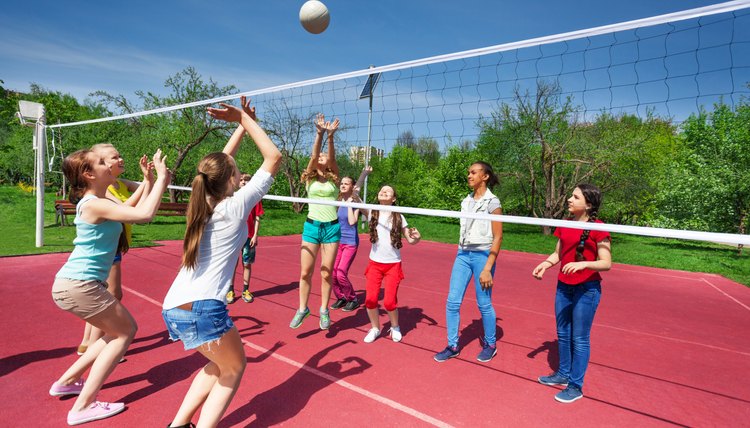Difference Between Soccer & Volleyball

Soccer and volleyball are sports that can be played both indoors and outdoors with teams of either men or women. But that's about where the similarities between the two end. The fundamentals for playing, rules, players' positions and physical requirements for each sport are very different, so skills and knowledge in one may not transfer over well to the other. Understanding the differences between them can help you determine which sport you want to participate in and which would better suit your skill set.
Hands or Feet?
Soccer and volleyball are fundamentally different in the way they are played. Volleyball is played using the hands and arms to move the ball around the court. The overhand or underhand serve is the first hit of the game and puts the ball into play; the bump is performed using your forearms and is used to pass the ball; and the set is an overhead pass and is used to set the ball up for the spike, which is an overhand hit to get the ball to the other side of the net. Soccer is played without the use of hands, with the exception of the goalie. who can use his hands to grab or block the ball to defend the goal. Soccer players use the inside and top of the foot to trap, pass and shoot the ball. The knees, chest and head can also be used to trap, pass and shoot, but are used less often.
Modes of Movement
Movement around the field of play also differs between volleyball and soccer. Most of the positions in soccer require a good amount of running throughout the course of the game. Players usually travel a significant portion of the field as they move the ball toward the opposing team's goal or hustle back to their side of the field to defend the goal. The goalie is generally stationary, but may need to run short distances to get to an incoming shot. Volleyball players usually do minimal running and generally only move around a small area. This is because a volleyball court is significantly smaller than a soccer field and each player tends to a designated section of the court. In soccer, one player can gain possession of the ball and move it up and down the field by dribbling; but in volleyball, each player is only in contact with the ball for one strike at a time and the ball is moved back and forth through a series of passes from one player to another.
Play Your Position
The number of players on each team and the positions they play differ between the two sports as well. In a volleyball game, each team can have six players on the court at once, three in the front and three in the back. Players rotate positions each time they win back possession of the ball, so everyone has to play every position and no player has a designated role. Each player will have an opportunity to serve, pass and return the ball to the opposite side of the court. In soccer, each team can have no fewer than seven and no more than 11 players on the field at a time including the goalkeeper, according to FIFA guidelines. Also, players are assigned specific positions, such as forward, midfielder, fullback, stopper, sweeper and goalie, based on skill set. Some players may alternate between a couple of positions, but it is general practice to develop competency in only one position.
How to Win
Soccer and volleyball are different in how the winning team is established. Determining the winner in soccer is fairly simple: get the ball in the other team's goal without using your hands and you score one point. The team with the most points at the end two 45-minute halves wins the game. Volleyball is a bit more complicated. If the ball is grounded on the opposing team's side, your team scores one point. But players have one hit to get the ball to the opposite side when serving, and three hits to get the ball to the opposite side when returning the ball. Also, only players at the net can spike the ball over the net. If a backcourt player hits the ball over the net, it must done from behind the attack line. Further, a match consists of five sets. The first four sets are played to 25 points and the last set is played to 15 points, according to FIVB guidelines. Each set must be won by two points, so sets will continue until this is achieved. The team who wins the best three of five sets wins the match.
References
Writer Bio
Based in the Los Angeles area, Brandi Junious specializes in health-related articles. Her writing reflects her expertise in fitness and education. Junious is the author of children's book "A World Without Trees" and her work has appeared on Modern Mom, The Nest Woman, Chron Healthy Living and at Loseweightandlivehealthy.blogspot.com. Junious holds a bachelor's degree in psychology from the University of Southern California and a master's degree in Education.
